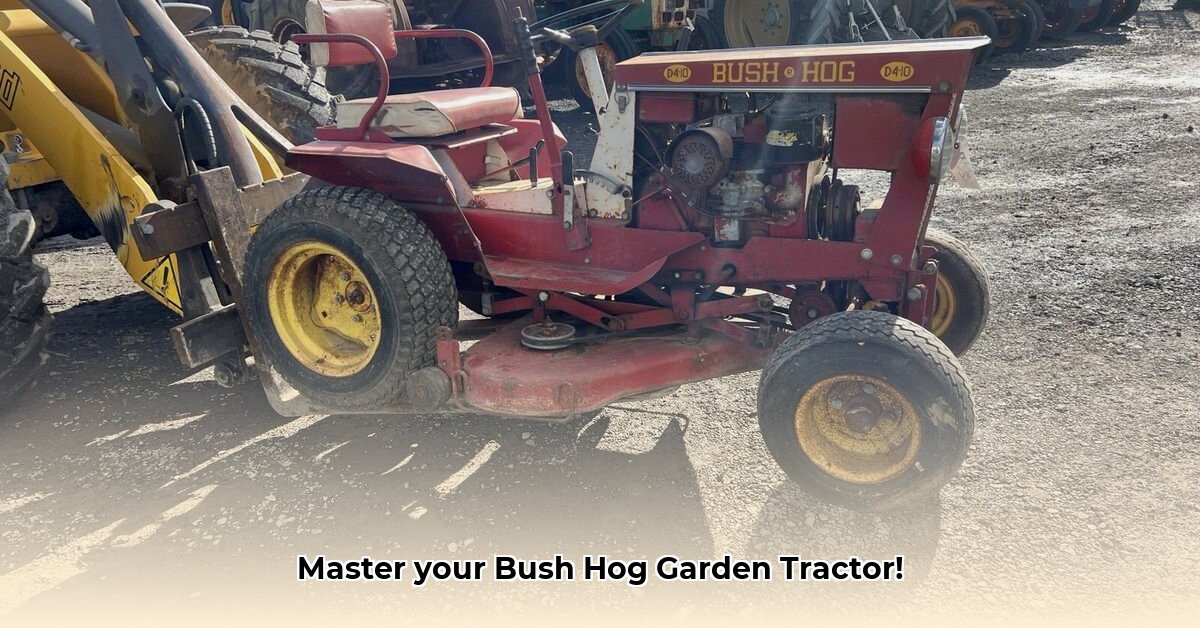
Bush Hog Garden Tractors: A Deep Dive into History and Models
Bush Hog garden tractors, manufactured primarily from 1962 to 1972 in Galesburg, Kansas, represent a significant yet often overlooked chapter in small-engine agricultural machinery. More than simple lawnmowers, these machines reflect the engineering and market forces of their era. This guide provides a comprehensive overview of Bush Hog's history, model variations, and the collector's market surrounding these machines. Understanding their technical specifications and historical context is key to appreciating their enduring appeal. For those interested in building their own, check out this guide on tractor building.
Historical Context: The Rise and Fall of Bush Hog
Bush Hog Manufacturing Co., while best known for its rotary cutters, also produced a range of garden tractors. These machines were designed for both residential and small-scale agricultural use, reflecting a shift towards more accessible power equipment. The company's approach to design and engineering choices, detailed later, reveals a fascinating blend of robust construction and cost-effective adaptations. Did you know that the choice of engine type significantly impacted both performance and the overall cost of these tractors?
Detailed Model Breakdown: Exploring the Bush Hog Lineup
The Bush Hog tractor lineup offers a diverse range of models, each with its own unique specifications and features. This section provides a detailed breakdown of the most common models, highlighting key differences and variations.
The T-63 (1962-1965): The Original Workhorse
The T-63, an early model, established the foundation for subsequent Bush Hog tractor designs. Its robust construction and powerful Wisconsin S7D engine made it a high-end option, though comparatively rare today.
The V-Series (Various): Expanding the Options
The V-Series expanded the Bush Hog lineup with various models (e.g., V4-6, V4-7, V3-6) featuring different engine sizes and transmissions, targeting varied budgets and needs. This series marked a strategic shift toward more accessible pricing.
The D4-7 (1966-1968) and D4-10 (1966-1972): Popular and Widespread
The D4-7, a direct descendant of the T-63, retained the robust Wisconsin S7D engine. However, the incredibly popular D4-10 offered greater engine choice (TR10-D, TRA10-D, Tecumseh HH100), providing consumers with increased flexibility. Even minor details varied, such as wheel rim color (yellow or white).
The HD-Series (Mid-1966-1968): Built for Heavy Duty
The HD-10 and HD-12 models offered heavy-duty capabilities for more demanding tasks. Their Sunstrand Hydrogear transaxle provided smoother operation than gear-driven systems. Some HD-12 variants (HW-12) featured wider tires for enhanced stability.
The JB-Series (1971) and V4-8 & V4-10 (1971): End-of-Line Models
The JB-Series, launched near the end of production, shared similarities with the D4-10 chassis but incorporated a 12hp Tecumseh engine. The later V4-8 and V4-10 continued the V-Series' belt-drive design. Both are relatively rare.
Engine and Drive System Variations: A Technical Overview
Understanding the engine and drive system differences is crucial to appreciating the evolution of Bush Hog tractors.
Engine Choices: Wisconsin vs. Tecumseh
Early models utilized durable Wisconsin engines, renowned for longevity and power. Later models transitioned to Tecumseh engines, offering a more budget-friendly alternative, reflecting industry-wide cost pressures. How did this shift impact the overall lifespan and performance of the tractors?
Drive System Comparisons: Gear vs. Belt
Bush Hog tractors employed two primary drive systems: gear-driven and belt-driven. Gear-driven systems offered direct and efficient power transmission but at a higher cost. Belt-driven systems, introduced later, were simpler and less expensive but potentially less durable and efficient. What trade-offs did the company make regarding these design choices?
Rarity and Collectibility: The Bush Hog Collector's Market
Certain Bush Hog models are more rare than others, driving their desirability among collectors. Rarity is influenced by production numbers, unique features (optional PTOs, engine types, rim colors), and overall condition. The quest to find and restore a rare Bush Hog is a rewarding challenge for many enthusiasts. But what specific features contribute most to a model's rarity and value?
Parts Sourcing and Restoration: Keeping the Legacy Alive
Restoring a Bush Hog presents challenges, particularly in sourcing replacement parts. However, dedicated online communities and parts suppliers provide resources for those undertaking this rewarding but demanding process. What strategies are employed by dedicated collectors when sourcing these vital parts?
Conclusion: The Enduring Appeal of Bush Hog Tractors
Bush Hog garden tractors represent a notable period in the evolution of small farm equipment, reflecting both technological advancements and the economic realities of the time. While production ceased decades ago, their legacy lives on through passionate collectors and enthusiasts who appreciate these machines’ history, engineering, and unique characteristics. Further research into specific model variations and their production numbers would further enhance our understanding of this fascinating chapter in agricultural machinery.
Key Takeaways:
- Bush Hog tractors reflect the balance between robust construction and cost-effective solutions.
- Models varied significantly in engine, drive system, and features, reflecting changing market demands.
- Certain models are highly sought after by collectors, creating a vibrant enthusiast community.
- Restoring a Bush Hog can be challenging but rewarding, thanks to available online resources and support networks.